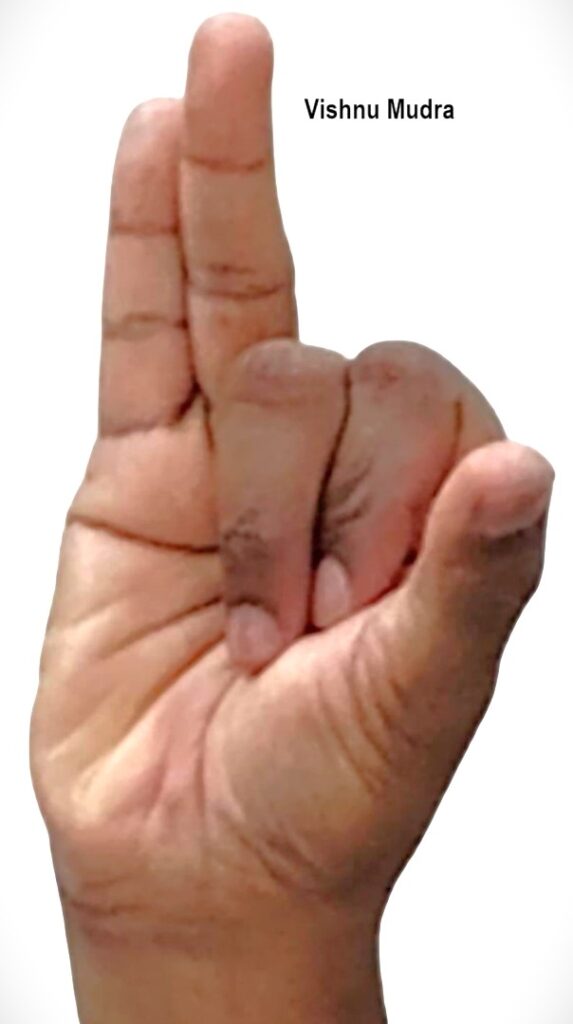Vishnu Mudra
Introduction
Vishnu Mudra is a yogic hand gesture primarily used in pranayama practices, particularly Nadi Shodhana (alternate nostril breathing). It is named after Lord Vishnu, the preserver in Hindu mythology, symbolizing balance, harmony, and control over energy.
This mudra is used to control the flow of prana through the nostrils, enhance focus, and improve respiratory and nervous system functions. It is a key technique in yogic breathing exercises and meditation practices.
Meaning
Vishnu: The preserver; symbolizes balance, protection, and stability.
Mudra: A gesture or seal used to influence energy flow.
Overall Meaning:
Vishnu Mudra regulates breath, harmonizes pranic energy, and balances mental and emotional states.
How to Perform / Practice
Sit comfortably in a meditative posture (Padmasana, Sukhasana, or Vajrasana) with a straight spine.
Raise your right hand to the face.
Fold the index and middle fingers inward, touching the palm.
Keep the thumb, ring finger, and little finger extended.
Use this mudra to close the right nostril with the thumb and the left nostril with the ring finger during alternate nostril breathing (Nadi Shodhana).
Maintain slow, deep, and controlled breaths while focusing on energy flow.
Practice for 5–15 minutes daily, gradually increasing duration.
Tip: Can be practiced anytime, especially during meditation, pranayama, or before sleep.
Benefits
Physical Benefits:
Improves respiratory efficiency and oxygenation.
Regulates blood pressure and heart rate.
Strengthens lungs and diaphragm.
Supports detoxification and energy balance.
Mental & Emotional Benefits:
Calms anxiety, stress, and mental agitation.
Enhances concentration, focus, and emotional stability.
Balances left and right brain activity.
Energetic / Spiritual Benefits:
Harmonizes Ida and Pingala nadis (energy channels).
Promotes smooth flow of prana throughout the body.
Encourages meditative state and inner balance.
Contraindications
Avoid if experiencing hand injuries or arthritis affecting finger movement.
Not recommended for severe respiratory conditions without medical supervision.
Discontinue if dizziness or discomfort occurs during practice.
Practice moderately if experiencing excess Pitta, to avoid overheating during pranayama.
Anatomy & Physiology
Muscles: Engages intrinsic hand muscles (lumbricals, interossei) to maintain finger flexion.
Joints: Flexion at index and middle fingers; extension at thumb, ring, and little fingers.
Respiratory System: Facilitates controlled closure of nostrils for alternate breathing.
Nervous System: Activates parasympathetic pathways, promoting relaxation and mental focus.
Circulation: Improves oxygen exchange and systemic energy balance.
Kinesiology
Enhances fine motor coordination of fingers for precise nostril closure.
Supports static postural stability during seated meditation or pranayama.
Encourages relaxed hand posture, aiding focus and energy flow.
Neurology
Stimulates brain regions associated with attention, emotional regulation, and autonomic control.
Balances sympathetic and parasympathetic activity, reducing stress and anxiety.
Supports neural pathways for breath control, relaxation, and energy regulation.
Duration of Practice
Daily Practice: 5–15 minutes during Nadi Shodhana or meditation.
Short Practice: 1–5 minutes for quick relaxation or mental focus.
Can be combined with Dhyana Mudra or Chin Mudra for deeper meditative benefits.
Counter Mudra
There is no strict counter mudra, but relaxing the hand in Gyan Mudra between sessions helps reset energy.
Gentle stretching or shaking of fingers is recommended after prolonged practice.
Conclusion
Vishnu Mudra is an essential hand gesture for pranayama and meditation, helping to regulate breath, balance pranic energy, and enhance mental and emotional stability. Regular practice improves respiratory efficiency, concentration, and inner calm, making it a key tool for yogic and spiritual development.
FAQ
Q1: Can beginners practice Vishnu Mudra?
A: Yes, it is simple and safe; start with short durations and gradually increase.
Q2: Can it improve focus and meditation?
A: Yes, it enhances mental clarity, attention, and meditative depth.
Q3: Can it be combined with other mudras?
A: Yes, it pairs well with Dhyana Mudra, Chin Mudra, or Surya Mudra during meditation.
Q4: Is it safe for people with respiratory conditions?
A: Consult a physician before practicing if severe respiratory conditions exist.
References
Swami Satyananda Saraswati, Mudras for Healing and Transformation.
Iyengar, B.K.S., Light on Yoga.
Saraswati, S., Pranayama and Mudras in Yoga Therapy.
Fishman, L., Yoga for Emotional Balance.
Lad, V., Ayurveda: The Science of Self-Healing.
Journal of Bodywork and Movement Therapies, 2018; 22(4): Effects of Hand Mudras on Mental and Physiological Functions.

